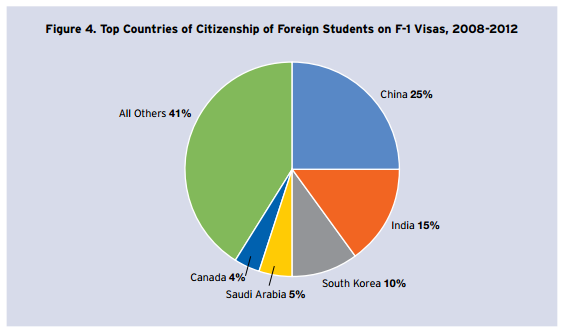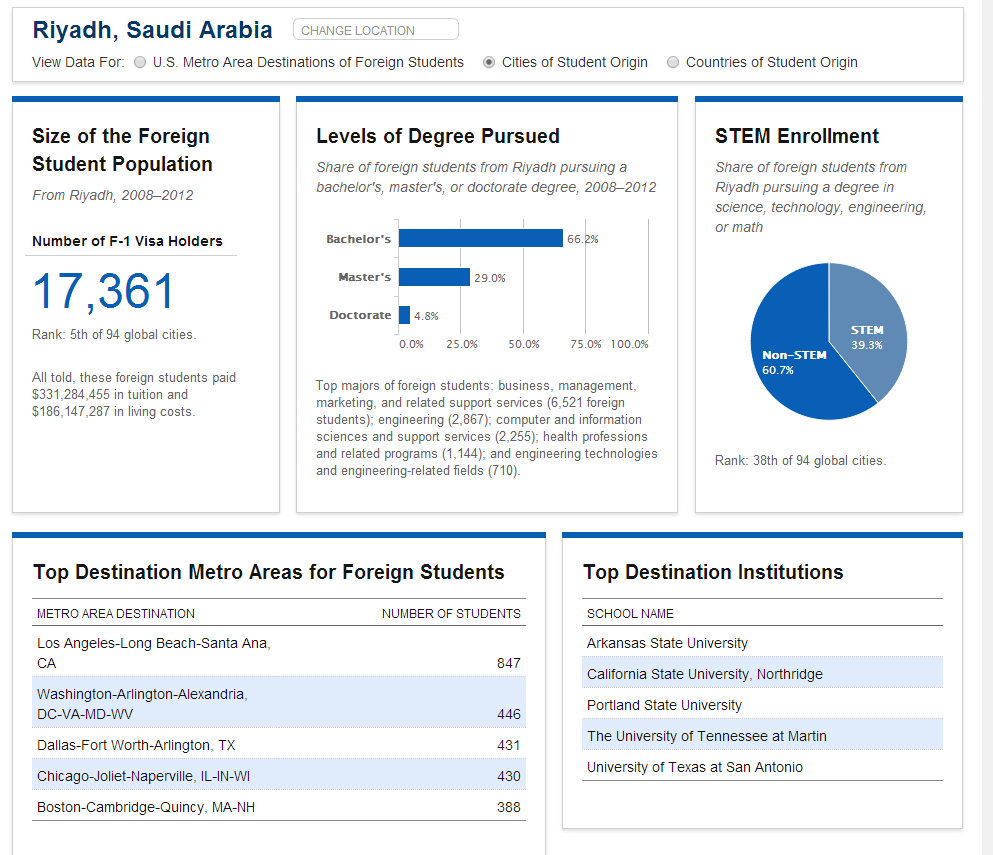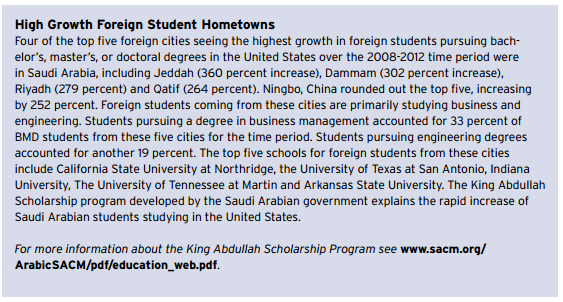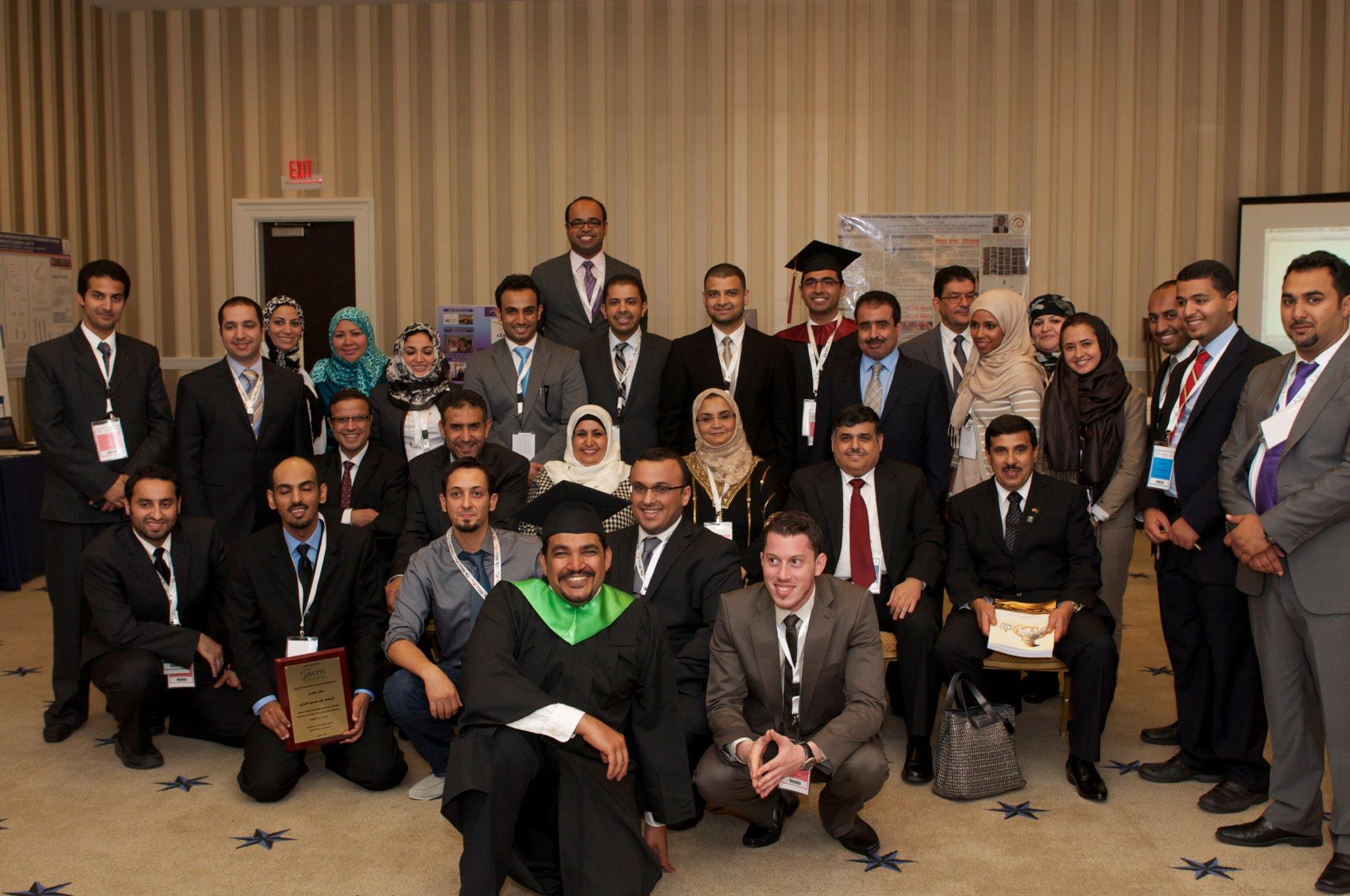The Brookings Institution has just published a superb report, The Geography of Foreign Students in U.S. Higher Education: Origins and Destinations, which mines foreign student data from the U.S. Immigration and Customs Enforcement to create an extraordinarily informative overview of the foreign student population in the United States.
The report covers the period from 2001-2012 when – in the aftermath of the 9/11 attacks – the numbers of students in the U.S. on F-1 visas grew from 110,000 to 524,000. Although the report is expansive it is not comprehensive as it tracks only the most common F-1 type visa which was held by 78.1% of all foreign students in 2012. Also, since the latest available data is to 2012, it might not fully reflect current numbers. For example, as of 2012 there are 53,828 Saudi F-1 visa holders in the U.S. ranking Saudi Arabia 4th out of 74 countries. China, India and South Korea are the top three countries. However, since 2012 another 30,000 Saudis have come to study in the U.S.

While Brookings’ research methodology is creative and offers significant new data on this important subject, the report is especially valuable due to its conclusions and the level of detail possible with regard to where students come from, where they go, what they study and how much they spend.
Data is pulled for 74 countries and 94 cities of origin. So you can view data on Riyadh, Saudi Arabia that tells you how many Saudi F-1 visa holders were in the U.S. from 2008-2012, the level of degree they pursued, percentage of STEM and non-STEM degrees, top destination U.S. metros areas, top destination institutions and even how much was paid in tuition and living costs. For Saudi Arabia, data subsets are available for Dammam, Dhahran, Jeddah, Qatif and Riyadh.

The Geography of Foreign Students in U.S. Higher Education: Origins and Destinations Summary of Findings includes:
-
Foreign students are concentrated in U.S. metropolitan areas. From 2008 to 2012, 85 percent of foreign students pursuing a bachelor’s degree or above attended colleges and universities in 118 metro areas that collectively accounted for 73 percent of U.S. higher education students. They contributed approximately $21.8 billion in tuition and $12.8 billion in other spending—representing a major services export—to those metropolitan economies over the five-year period.
-
Most foreign students come from large fast-growing cities in emerging markets. Ninety-four (94) foreign cities together accounted for more than half of all students on an F-1 visa between 2008 and 2012. Seoul, Beijing, Shanghai, Hyderabad and Riyadh are the five foreign cities that sent the most higher education students to the United States during that time.

-
Foreign students disproportionately study STEM and business fields. Two-thirds of foreign students pursuing a bachelor’s or higher degree are in science, technology, engineering, mathematics (STEM) or business, management and marketing fields, versus 48 percent of students in the United States. Both large (San Jose, Calif.) and small (Beaumont-Port Arthur, Texas) metro areas figure among those with the highest shares of their foreign students in STEM disciplines.
-
Forty-five (45) percent of foreign student graduates extend their visas to work in the same metropolitan area as their college or university. Metro areas that retain high shares of their foreign graduates under the temporary Optional Practical Training (OPT) program tend to be either large diversified economies (e.g., New York, Los Angeles), or specialized labor markets that align closely with foreign graduates’ training (e.g., Honolulu, Seattle, Las Vegas).
Most importantly, the report highlights the economic benefits derived to those metropolitan centers that attract foreign students.
Interestingly, even with the rapid growth of foreign students in the United States since 2001, their total percentage of those enrolled in U.S. institutions of higher education remains consistent with historic levels.
Download the PDF for this report and bookmark the link. This is a worthwhile read and a resource you will return to frequently.









